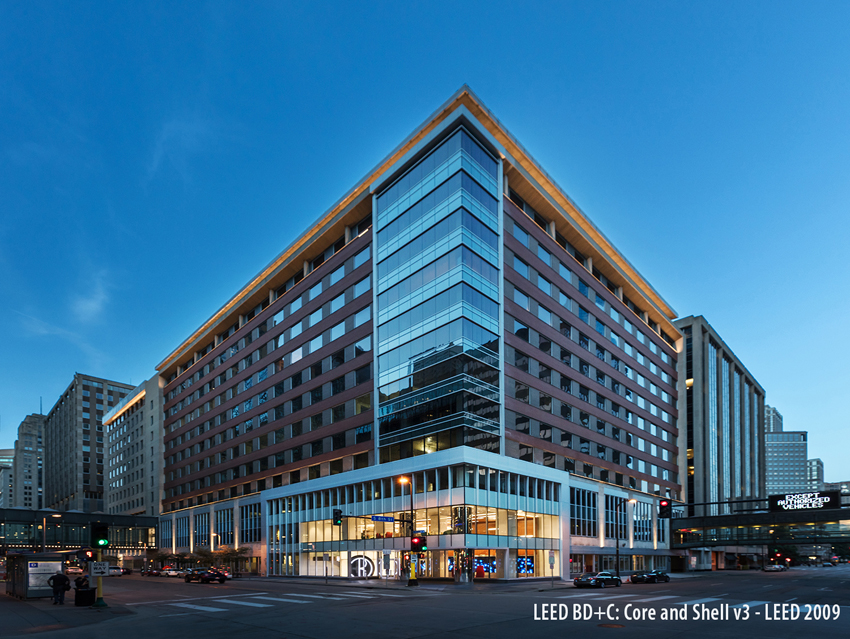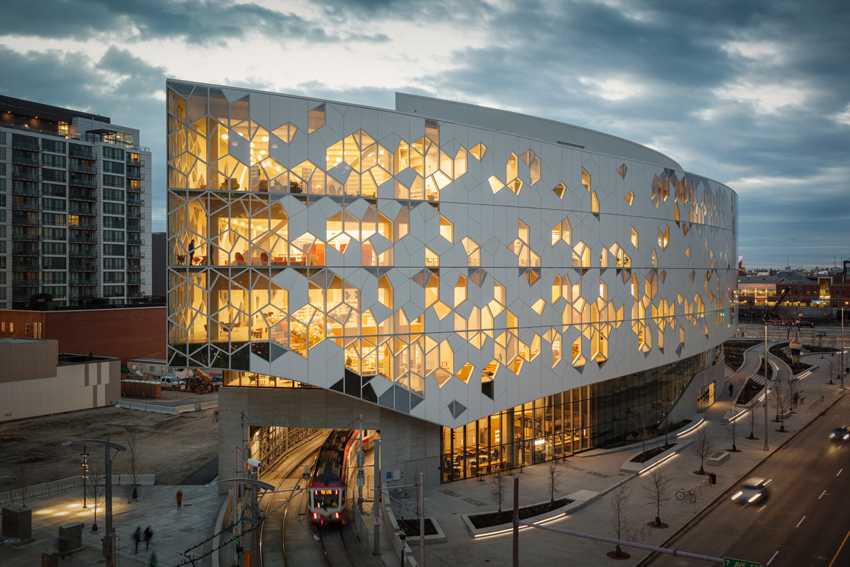Creating High-Performance Building Facades
New materials, products, and systems create better results that enhance designs
![]() Continuing Education
Continuing Education
Use the following learning objectives to focus your study while reading this month’s Continuing Education article.
Learning Objectives - After reading this article, you will be able to:
- Identify and recognize the structural, aesthetic, and performance aspects of opaque, insulated portions of building facades.
- Assess the energy performance and wellness aspects of glazing systems and glass as they relate to sustainability and code compliance.
- Explain the importance of specifying and installing the appropriate seals to use in facade joints and expansion joints.
- Determine ways to incorporate the principles presented in this course into specific building facades as shown in case studies.
Building facades continue to command a great deal of design attention. Some of that is driven by the ability to use advanced computer programs that allow for the analysis and development of shapes, surfaces, and geometries that were previously unthinkable using prior drafting and design techniques. Other activity is derived from the development and advancement of new or updated materials, systems, and products that provide better performance, better aesthetics, and smoother construction installation than ever before. Yet in all of this newness and creativity, there is still the need to pay attention to the basics of making facades weather-tight, allowing for appropriate expansion and contraction, complying with building and energy codes, and remaining budget friendly. In this context, this course looks at several current facade products and systems. First, we look at some innovative materials that are being used for opaque portions of facades that offer new looks, innovative mounting techniques, and better performance overall. Next, we focus on the transparent portions of a facade by looking at glass and glazing systems that use advanced product development to achieve higher levels of energy performance. Finally, we address the need to pay attention to the joints and seams of a facade, particularly where expansion joints are involved for overall longevity and durability. Collectively, all of these features combine to allow architects to create 21st century building facades meeting a variety of design goals and performance needs.
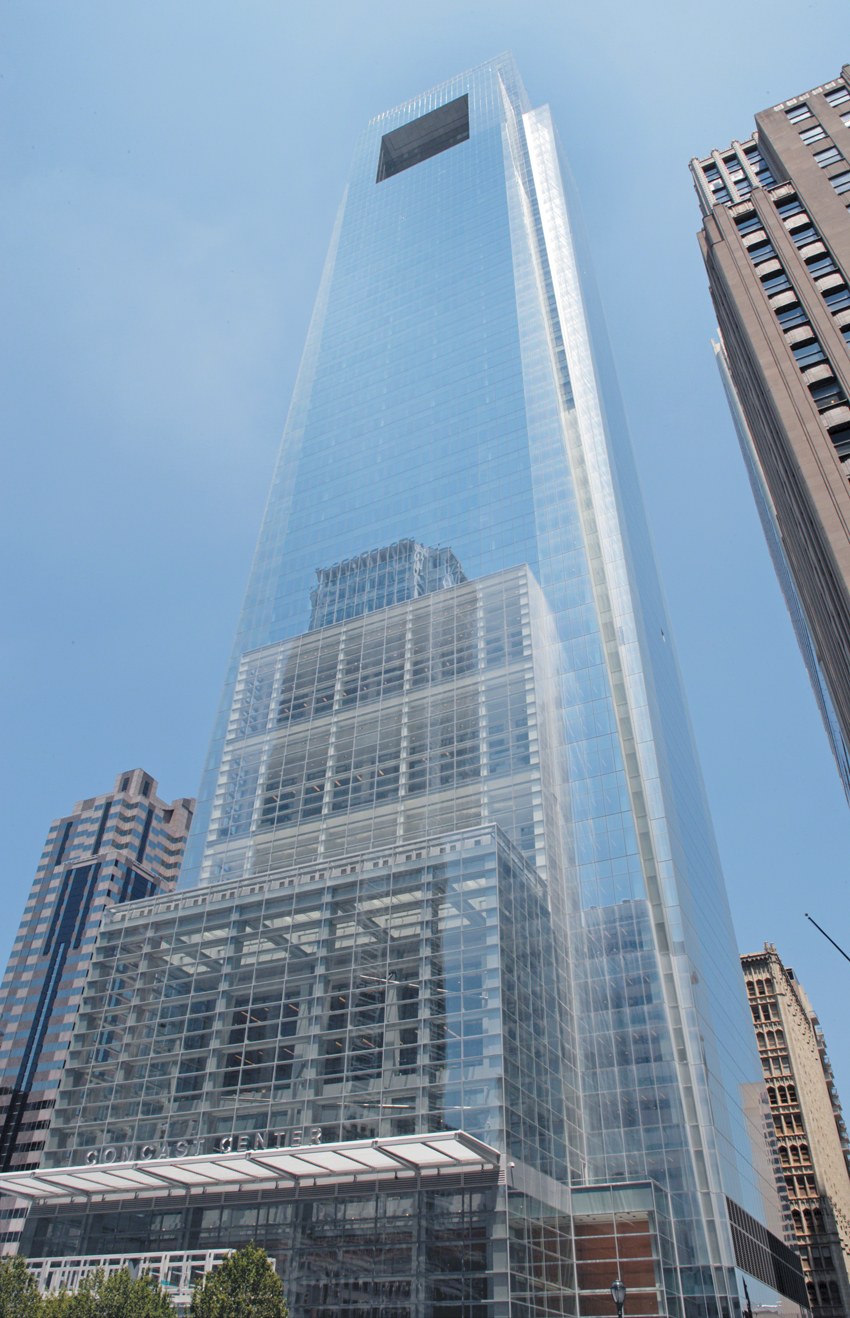
Photo courtesy of Vitro Architectural Glass
Advances in design, fabrication, and materials allow for greater creativity in building facades while still meeting or exceeding performance requirements.
Opaque Facade Areas
The design of many commercial building facades looks for the best balance of opaque and transparent areas. Historically, heavy, opaque structural stone and concrete made up the majority of a facade, with windows set in prescribed openings. The advent of structural steel and reinforced concrete framing systems allowed the facade to be separated from the main structure. This produced design freedom to incorporate more glass and experiment with more creative forms. The contemporary means to develop a facade has grown out of this approach by using a cladding system or a curtain wall system hung to a structural frame. This retains the nonstructural aspect of the facade while allowing a wider variety of materials to be incorporated. Quite often, these materials include some type of natural stone, terra cotta, masonry, or concrete that can emulate a historic style or provide a certain aesthetic that is durable and long-lasting.
Without the need to provide structural support to the building, only to itself, cladding and curtain wall systems are often designed and installed as comparatively lightweight, customized, modular sections. There are several aspects that come together to make this a successful undertaking.
Coordination
The first thing to address is that during the design or shop drawing stage, there is a great deal of coordination between the design architect, engineers, and facade contractor. There may also be a specialized consultant involved who focuses on curtain wall and cladding systems. In some cases, the fabricator of the curtain wall or cladding system may offer extensive design and engineering services for their products. They may also serve as a one-stop source for both cladding materials and support systems. The key is to engage everyone in the process early on so that design options can be reviewed, construction capabilities or limitations confirmed, installation processes reviewed, and costs controlled.

Photos courtesy of HOFMANN FACADES
Ultra-high-performance concrete (UHPC) is being used to create building facade panels that are visually striking, custom designed, lighter weight, and easier to install. An example is the case shown above, where UHPC was combined with a beige limestone veneer.
Material Selections
Exterior architectural cladding can be made from a variety of natural and man-made products. Quarried natural stone cladding is popular because it is a proven product that is highly versatile with many finish options. Varieties can include granite, limestone, sandstone, or others, each of which will have different visual and performance characteristics. As a natural material, it has a very low carbon footprint and requires comparatively low amounts of energy to produce. It is also typically very durable, requiring very little maintenance.
An emerging facade material is ultra-high-performance concrete (UHPC) formed into a panel and hung as part of a curtain wall or similar system. Aesthetically, its appeal is found in the virtually endless finish options in the color and texture of the concrete. It is also readily possible to integrate thin layers of other materials onto the outer surface, such as terrazzo, brick, terra cotta, wood, ceramic tile, or thin natural stone veneers. This is intriguing on flat surfaces but enhanced by the ability to readily form concrete into three-dimensional sections or panels that can add visual interest and depth to a facade.
In addition to the visual aspects of UHPC panels on a facade, its physical properties are notable too. The cast panels are typically thinner, lighter, and longer spanning than some stone or masonry materials. This equates to a reduction of the dead load weight on concrete or steel frame superstructures and foundations. Depending on the design, thinner systems mean more space for insulation and fireproofing, or it can mean a gain of usable (or rentable) interior floor space. Using less material helps to improve the overall carbon footprint of the building too.
Installation Techniques
The choice of materials and the type of system selected will directly influence the means for installing the facade. Heavier, thicker, and larger facade panels will likely require a crane for their installation. Smaller, lighter panels such as those made with UHPC can often be floor set and brought into place without the need for tower cranes or even scaffolding in some cases. The lighter weight also means that there may be fewer anchor points and penetrations of structural elements. All of this adds up to shorter installation cycles on-site and improved construction time schedules.
Philipp Hofmann, managing partner of Hofmann Facades, saw the advantages of UHPC facade panels play out very well at a recent hospital project in Germany. He notes, “This project led to the idea of a thin limestone facade, entirely unitized on UHPC instead of hand-setting it into place. This meant the project could be installed without any scaffolding, thus reducing cost and construction time.”
Sintered Stone Facades
Sintered stone is a proven material that has been used on facades both in the United States and in Europe for some time. Sintering refers to the atomic diffusion of particles, which occurs most quickly at higher temperatures. Applying this to sintered stone produces a thin, lightweight, and very strong material with properties similar to, but better than, porcelain ceramic tile. The primary difference is that sintered stone products are made from selected natural minerals and only the atmospheric humidity that they contain. The manufacturing process relies on the use of natural raw materials that are reduced to fine powders. The powders are then arranged by color and pattern and subjected to pressures on the order of 15,000 psi. The resulting thin slabs are then fired in a kiln producing large-format panels that can be 4 feet by 12 feet or 5 feet by 10 feet, among others. Thicknesses are generally available in 1⁄8 inch, 1⁄4 inch, and 1⁄2 inch.
Visually, sintered stone panels can be created that look like natural stone, a solid surface, textured surfaces, or custom looks in a wide range of colors. As a very dense, lightweight, and sustainably produced material (at least one manufacturer is carbon neutral as of 2019), sintered stone has been regarded by many architects worldwide as a facade material of choice suitable for the most demanding exterior building projects, whether commercial or residential. Its physical properties make it a high-performing, low-maintenance, easy-to-clean product that resists scratches, abrasion, graffiti, and ultraviolet light. It has been tested as a noncombustible product that does not propagate fire, heat, or smoke. It also exhibits a very low porosity (less than 0.08 percent), making it virtually waterproof without the need for additional coatings or sealers. As such, it can contribute directly to the longevity and resilience of the building facade.

Photo courtesy of Neolith®
Sintered stone panels provide a lightweight, durable, easy-to-work-with facade material that is available in a wide range of colors, textures, and finish treatments.
From a construction standpoint, sintered stone panels are lightweight and easy to work with. They can be securely applied relatively quickly, creating efficiencies in the construction process compared to other materials. Specifically, for facade systems, there are three common methods of attachment:
- Exposed mechanical cleating: Recognizing the common desire for providing ventilated rainscreen style facades, sintered stone panel manufacturers have worked to provide systems to suit these situations. Comprised of a self-supporting metal structure originally designed to support ceramic tiling in different formats and thicknesses, it has been refined to suit sintered stone panels too. This approach is based on a visible mechanical fixing system comprised of supports made from vertical T- or L- shaped profiles and safety clamps to which the sintered stone panels are attached.
- Hidden chemical fixation: In cases where concealed fastening is preferred, hidden support systems are available that use a longitudinal elastic chemical adhesive with vertical aluminum supports. Those supports can be in either T- or L-shaped profiles depending on whether they are used to coincide with the joints between the sintered stone panels or to reinforce the center of them.
- Hidden mechanical (hybrid) fastening: At least one manufacturer has created a mixed (chemical and mechanical) hidden profile system that works due to the pressure created by the system in the rear of a sintered stone panel. This is achieved with a double groove at opposing 45-degree angles (like a dovetail in carpentry terms), where two aluminum profiles are inserted and fixed with structural adhesive to secure the channels to the panels. The connected channels are then secured to the aluminum support system holding up the whole facade. The panels can hang and be levelled either to align with adjacent panels or be staggered without needing to increase the number of vertical supports. In all cases, this method of attachment allows the support system to become invisible due to the concealed fastening and aluminum members. It also allows for easy removal and replacement of panels if ever necessary.
In addition to the above, there are other aspects of sintered stone that make it an exceptional choice for facades in urban environments. A significant new coating process (supplied by a third party) is now available to reduce outdoor air pollution. This coating uses an additive with titanium dioxide in a nanoparticle-based treatment that can be specified and baked-in during the manufacture of the sintered stone slabs. The treatment uses the process of photocatalysis in an ongoing chemical reaction between the added titanium dioxide and sunlight falling onto the facade. When sunlight (or some LED lights) shine on the surface, the titanium dioxide particles are activated using the light energy to transform moisture in the air into oxidizing agents. This destroys nitrogen dioxide particles and other contaminant compounds, and chemically transforms them into harmless water vapor and salt. This photocatalysis process is repeated millions of times per second until all contaminants are destroyed, meaning the surface as well as the surrounding air are constantly being self-treated and cleaned.
Tahir Demircioglu, principal architect of the firm Builtd, chose treated sintered stone panels for a facade in a recently completed New York skyscraper. He explains, “The initial selection of the sintered stone panels was for their lightness and aesthetic qualities, but once we found out that they came with this air-cleaning element, we said, ‘Of course!’ It is a huge plus that these treated panels also limit the amount of maintenance required. Instead of using chemicals and power-washing the facade, the material is hydrophilic, so it cleans itself.”
Energy-Conserving Fenestration Systems
Fenestration usually figures prominently in most building facades. This can include windows, doors, louvres, vents, wall panels, skylights, storefronts, curtain walls, and sloped glazed systems. For any of these systems to be installed in a building facade, they need to have a manufactured frame to hold them in place and secure them to the rest of the building. In most commercial buildings, the material of choice is usually an aluminum frame or support system of various types. The reasons for its use are based on its lightweight but inherently strong nature as a material, its ability to avoid rust or corrosion, its rather economical workability, and the variety of colors and finishes in which it is available. However, it is also an excellent conductor of heat, which makes its use on building facades a concern when addressing energy-conserving design and compliance with energy codes, as the aluminum acts as a thermal bridge between inside and outside. This is true in both cold and warm climates as well as extreme weather conditions.
Manufacturers of aluminum framing systems for fenestration have been addressing the thermal issue for decades and continue to develop products that maintain their structural integrity while offering improved thermal performance. The key component is the addition of a thermal break or barrier in the aluminum frames, usually in line with the location of glass or other glazing in the frame. The intent is that the interior and exterior portions of the frame are separated with a structurally rigid but less thermally conductive material. The details of how that break is created and the choice of materials used are what tend to differentiate various products from each other.
Commonly, there are three choices of material used as thermal breaks or barrier material in commercial fenestration systems: vinyl plastic, polyamide nylon, and polyurethane polymer. Each has different thermal and structural properties, so finding the best choice is a combination of understanding these properties and the way they work with the details of a particular aluminum frame profile. This relationship is what manufacturers work on improving and perfecting to provide products that are reliable, economical, and functional.
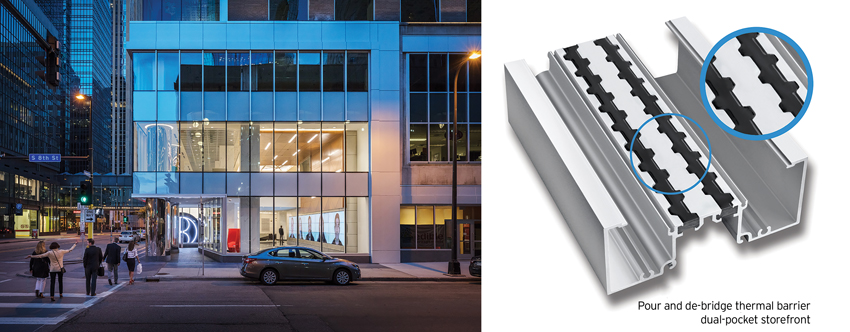
Photo: © Paul Cosby Architectural Photography; Image: © Tubelite Inc.
The aluminum framing used in fenestration systems include tested and proven thermal breaks or barriers to improve thermal performance while maintaining structural integrity and overall performance.
Of late, polyurethane has received a good bit of attention as a thermal-barrier material in aluminum frames since it can provide superior thermal performance to other choices. For example, using standard test procedures based on the National Fenestration Rating Council (NFRC) 101, U-factors of frames with different thermal-barrier materials can be determined. In a comparison of thermal conductivity of materials according to ASTM C518 standard test method, polyamide 6.6 with 25 percent glass fiber showed a thermal conductivity of 2.08. By contrast, a vinyl barrier produced a better (i.e., lower) result at 1.18, while polyurethane performed the best at 0.84. The significance of the differences in performance, as it relates to the design of the aluminum frame, is that a lower-conducting material will not need as wide a gap to achieve a targeted thermal performance. For example, in at least one frame comparison, a polyamide thermal barrier was used to achieve a U-factor of 0.39 but required a 24-millimeter gap to do so. By contrast, a polyurethane barrier was used to also achieve a U-factor of 0.39 but only required a 15.8-millimeter gap. A smaller gap can mean better structural performance of the frame and possibly thinner overall profiles of products. Hence, achieving better thermal performance in thinner breaks has advantages when seeking to create better fenestration products that allow better sightlines, more structural integrity, and durability.
The most proven approach to effectively install the thermal-barrier material that isolates the inner and outer frames is referred to as a “pour and de-bridge” process. This is based on first creating an extruded aluminum profile that has been designed with a strategically placed channel in the middle of the frame piece. This channel is typically U-shaped and open to the top to receive the thermal-barrier material. Once ready, the thermal-barrier material is installed using specialized equipment designed for this purpose. If polyurethane is used, then it is literally poured in liquid form into the predesigned channel. Then, within minutes, polyurethane solidifies into a very strong structural polymer. The final step in the process cuts and removes the metal thermal bridge from the bottom of the channel to produce a true, non-metal-to-metal structural thermal barrier. This pour and de-bridge method is suitable for withstanding demanding climates and conditions with high-performance requirements in terms of impact resistance, shear strength, and heat distortion.
Remarking on the capabilities of such systems, Mary Avery, vice president of marketing at Tubelite, explains, “In colder climates, this type of system provides superior energy results and condensation resistance using multiple thermal barriers, while providing structural integrity and aesthetic flexibility.” She continues, “Optimizing thermal performance helps lower the load on HVAC systems and reduces associated energy costs, while maintaining a comfortable interior temperature.” She also notes that the reduction of condensation can improve a building’s appearance and minimize moisture damage to adjacent building materials.
Higher-Performance Glass
The use of glass in building facades is not only ubiquitous, but it can also be the dominant aspect of the aesthetic look of many commercial building designs. When it is used in even a moderate quantity, it directly affects the thermal performance of a building too. This is true in cold climates, where the concern may be heat loss from inside to outside, and in moderate to warm climates, where the concern is heat gain from outside to inside.
Glass manufacturers have responded with increasingly sophisticated approaches that involve improvements not only to double-paned insulated glass units (IGUs) but also the treatments applied to the glass surfaces. All of this is coupled with general improvements in glass types that produce greater clarity, less coloration, and more visibility—all while mitigating the potential negative impact on thermal performance. And, because this is becoming widely adopted, the cost of this latest generation of glass products is in line with many project budgets. This is all good news for architects since it means that there are now more opportunities to meet higher performance requirements without sacrificing design requirements in building or renovation projects. How are these impressive results achieved? Typically, by combining better glass choices with better coating technology.
Improving Clarity
“Clear” glass is popular in a variety of architectural applications. However, design professionals know that clear glass is not completely clear—it has a distinct green hue when viewed under normal light conditions. Since the green color comes from the presence of iron in the glass when it is manufactured, the way to overcome that condition is to use glass made with lower amounts of iron. “Low-iron” glass can be 60 percent less green than “standard” clear glass for everyday projects, or up to 87 percent less green for projects demanding the utmost transparency.
Of course, a double-glazed IGU consists of two glass lites, separated by an airspace. Manufacturers point out that design professionals often specify a double-glazed IGU with low-iron glass as the exterior lite—typically to achieve greater transparency and color fidelity—and then use clear glass as the interior lite. However, this compromises the design intent of maximizing daylight and color fidelity, as the green hue that is inherent in clear glass will dilute the clarity of the low-iron glass on the exterior lite. Using low-iron glass for both lites in a double-glazed IGU will help achieve a truly transparent look.
Enhancing Performance
Low-emissivity (low-e) coatings are commonly applied to glass in the interest of reflecting heat away from the glass. These coatings consist of extremely thin layers of silver that are applied to the glass substrate through a magnetron sputter vacuum deposition (MSVD) process. These layers of silver reflect infrared (heat) radiation back away from the glass, helping to keep a room either warmer or cooler as desired. This makes the glass-enclosed spaces more comfortable while also helping to control energy costs related to heating and cooling the space. The relative transparency of these coatings also helps transmit natural daylighting, which can improve health, wellness, and productivity, while also allowing electric lights to be turned down or off.
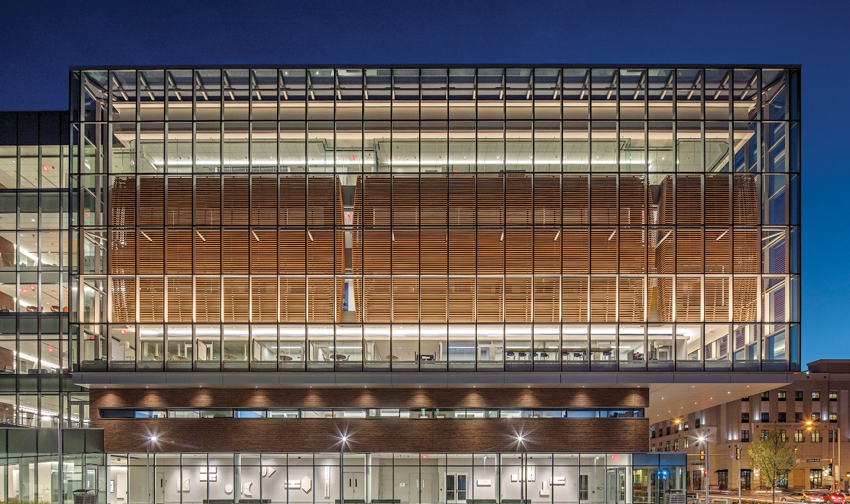
Photos courtesy of Vitro Architectural Glass
Low-iron glass is available at different levels of clarity to suit design and budget requirements.
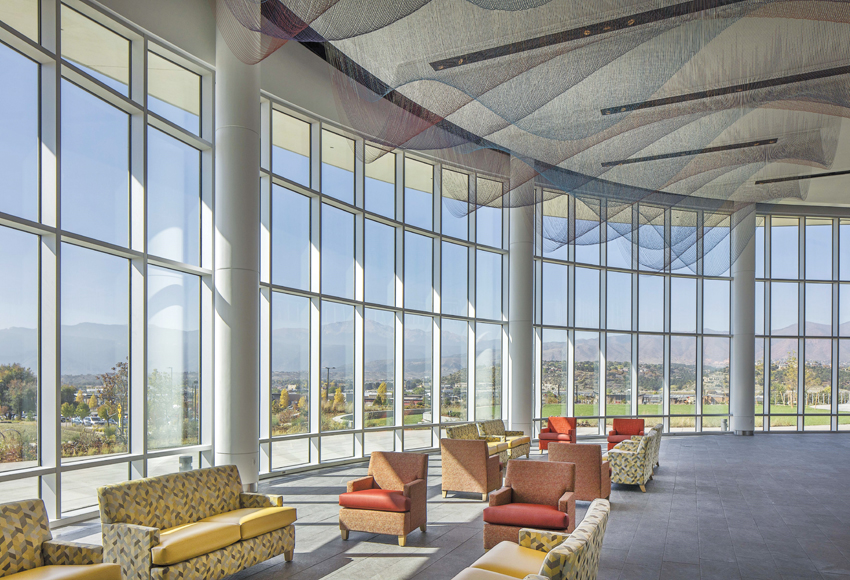
High-performance glass can help create interior spaces that are comfortable for people while reducing energy costs for heating, cooling, and lighting.
Optimizing Results
Different building projects require different glass solutions to achieve the best results. In cases where clarity, color correctness, and energy performance are all required, it makes sense to consider combining high-performance low-e coatings on low-iron glass. Manufacturers who offer such glass systems point out that they combine exceptional solar-control performance with neutral aesthetics, enabling larger expanses without sacrificing occupant comfort. Options are available that offer excellent clarity even using a mix of low-iron and low-e choices. For example, a 1-inch IGU with a mid-range low-iron glass, with an advanced low-e coating as the outboard lite and uncoated mid-range low-iron glass as the inboard lite, can achieve visible light transmittance (VLT) up to an impressive 53 percent with a solar heat gain coefficient (SHGC) of a very low 0.23.
It is worth noting that this approach can be used for all types of glass conditions, including the emerging need for bird-friendly installations. Recognizing that expansive areas of glass can cause birds to accidently collide with them, regulations are in place or pending in many parts of the United States, Canada, and Europe to address this situation. As a result, manufacturers are offering high-performing solar-control, low-e glass that is combined with bird-safe, acid-etched patterns that can satisfy local and/or federal bird-safe glass codes. By placing acid-etched visual markers on the first surface of an IGU, which is preferred to prevent bird collisions, a low-e coating can be applied to the second surface—which is ideal from a solar-control standpoint.
Between the Lines: Choosing Expansion Joint Filler Systems
All facade materials and systems are made up of distinct parts or sections. The edges of those sections abut each other and require the use of a material to seal the joint between them. Similarly, on larger buildings, intentional expansion joints (gaps) are needed in the structure to allow for the movement of different parts of the building due to thermal expansion and contraction, seismic loads, or other conditions. Since all of these types of joints can interrupt the thermal, moisture, and air barriers in a facade, how they are treated and addressed will determine the continuity, or not, of these barriers across the joints.
From the standpoint of their performance, the key to successful joints often comes down to the selection of the material or type of system used to fill the gap in the joint. Effective choices include the use of manufactured foam seals, infilled “pan” systems, and metal cover systems. We will look at some of the choices below and comment on their suitability for different facade applications.
Closed-Cell Foams
Closed-cell foams are very watertight and do not allow the moisture to enter the body of the foam. This is the best application for horizontal runs where water could pool. These are tougher to compress but can be placed under tension or be pulled to expand quite well. The other key advantage of closed-cell foams is that they take well to heat-welding of seams. This renders a monolithic installation that reduces the risk of water infiltration.
A good rule of thumb/best practice when using closed-cell foam seals is to limit their application to a joint width of no more than 8 inches (200 millimeters) or smaller. Use of foams for expansion joints larger than even 6 inches leads to two things:
- Exceeding the foam’s performance characteristics. Plus, the weight of “super-wide” foam seals can lead to sagging in vertical applications.
- Dramatically higher costs compared to other expansion joint cover systems.
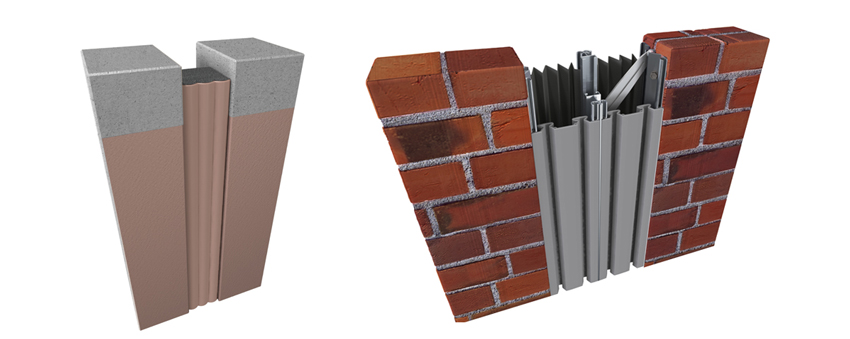
Images courtesy of Inpro
Foams and pleated seals can be used in narrow joint openings and compress or expand in relation to the building movement. They may not be the most cost-effective choice in some cases, however.
Open-Cell Foams
Yes, these products do allow for some flow-through of water vapor. Like many exterior veneer systems, if moisture becomes trapped in a wall cavity, building systems allow the moisture to wick out. This is a good attribute and a major focus to eliminate potential mold issues in vertical applications. Hence, open-cell foams should be employed only in vertical installations, where gravity can wick any absorbed water downward and away from the building enclosure.
Architects should also be aware that open-cell foams for expansion joints come in a maximum length of 5 feet, and because they are not heat-weldable, caulk must be used at the seams. This can introduce a future failure point as well as higher periodic inspection and maintenance costs should the seams need to be repeatedly re-caulked to prevent leakage. It is also important to know that while in a compressed state all foams may look the same, they are not.
Pleated Seals
As their name implies, pleated-seal joint systems are installed into a blocked-out joint area, and they absorb movement through compression and expansion of the pleats in the seal. The rubber-looking, corrugated joint material is also an excellent option for exterior application where waterproofing is required. These seals are best employed for heavy pedestrian and moderate vehicle loading. Proper use of two-part epoxies ensure solid adhesion to the deck, and heat-welded seams ensure watertight performance. The nominal joint width for these systems should not exceed 31⁄2 inches to 43⁄8 inches (89 to 111 millimeters) since the material cannot really handle wider applications than that. Since these are often left exposed, building facade aesthetics can be enhanced using colored compression seals.
Metal Covers
For larger openings on facades that require greater durability, it is often more economical and appropriate to use a metal expansion joint cover system. These systems rely on base elements that are secured to either side of the building joint with a cover plate that allows the building to move behind it. Properly fabricated and installed, these systems can be weathertight by using a flexible barrier behind the metal.
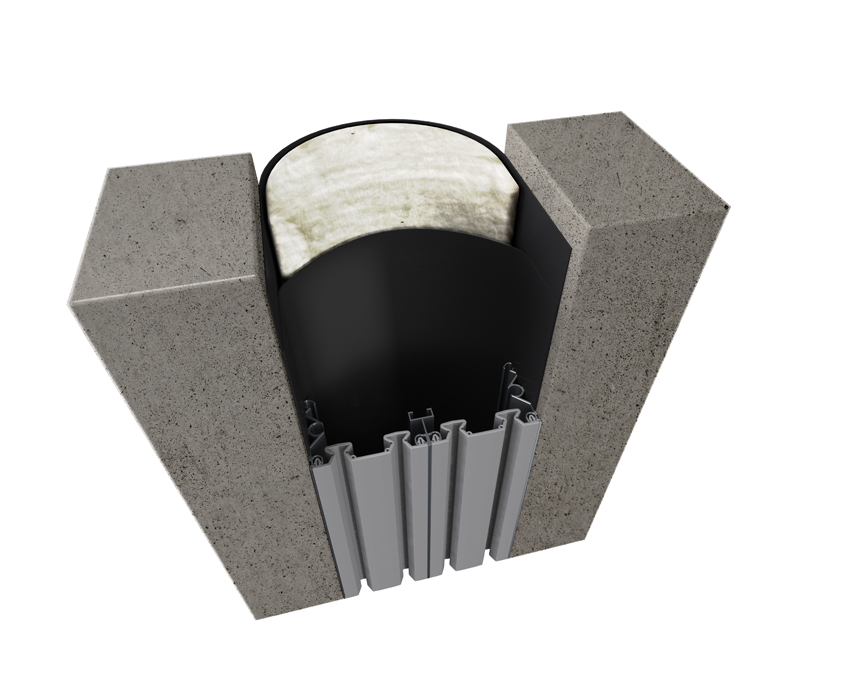
Image courtesy of Inpro
Insulated vapor barrier (IVB) expansion joint filler systems provide exterior facades with the needed movement while maintaining the equivalent R-values needed in walls.
Infilled Pan Systems
For cases where the appearance of the exposed metal cover plate is not desired, there is another option. Some metal systems are designed to receive a finish material in the center portion of the expansion joint cover while minimizing the exposed joint filler material. Referred to as an infilled pan system, these can be appealing for exterior and interior locations where larger joints need to be filled and durability addressed all in a manner that blends in with the general appearance of the surrounding surfaces, such as a building facade.
Vapor and Thermal Control
Regardless of the type of expansion joint filler system that is used, facades need to retain control of vapor and thermal transfer. For vapor or moisture control, one solution that can be used is to employ a reinforced vapor barrier (RVB) to prevent water infiltration or channel water to drain locations via an integrated drain tube. Most designers consider the RVB as the go-to standard for exterior wall expansion joints since they are a durable membrane that resides within the joint. They not only accommodate movement but also prevent the penetration of air, debris and pests from entering through the joint. The critical factor in installation of an RVB expansion joint system is to apply a bed of manufacturer-approved butyl sealant in the concrete block-out area or along the frame along the entire length of the expansion joint. This will aid in securing the moisture barrier to the concrete block-out and provide a watertight seal to prevent seepage around the perimeter of the joint. To work properly, always leave enough drape in the moisture barrier to ensure the system will be able to fully open to its maximum distance without interference from the expansion cover components.
Thermal performance in expansion joints is often overlooked in building design but is no less important than air and moisture performance. There is some minor insulating benefit from RVB joint systems, but an insulated vapor-barrier (IVB) system should be considered wherever thermal performance is important. The addition of insulation within the dual-walled vapor barrier provides a higher R-value—and the benefit, of course, is that the R-value works in both directions. Heat or cold do not penetrate the joint, and interior occupant comfort and HVAC performance are better shielded from the outside conditions along the entire length of the joint. IVBs are also capable of providing up to 50 percent movement, making them a seismic-capable system. They are suitable for use in expansion gap sizes from 6–28 inches.
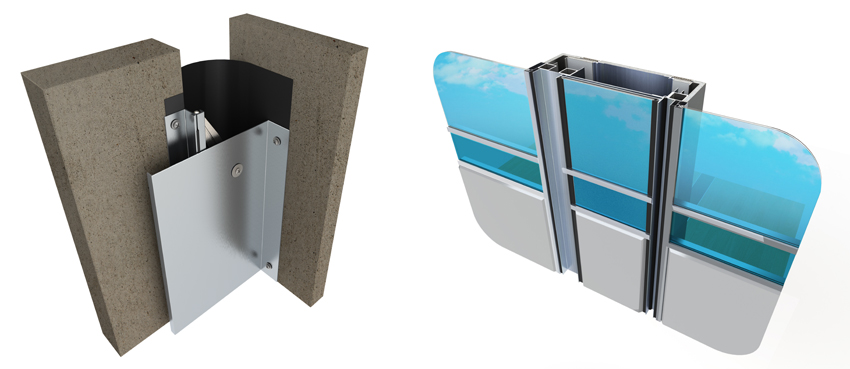
Images courtesy of Inpro
Metal covers and infilled pan systems allow expansion joints to be covered and sealed in facades to provide the needed protection and durability.
Tying In to Work of Other Trades
Expansion joints do not exist by themselves; they must be tied in to adjacent construction systems installed by other trades. Besides concrete, this can include wood framing, steel decking, steel studs and joists, exterior finish systems, masonry, and even glazing systems. The challenge—and frankly a potential failure point—is the reliance on the skilled craftsmen and women to tie their particular installation into adjacent materials and systems well. For instance, if the glazing specification and bid documents allow the glazing contractor to simply install the frame and glass and do not demand tie in to say an adjacent waterproof vertical expansion joint, it invites problems. The same thing works the other way too. If a waterproofing contractor installs the expansion joint system and does not tie in to the window glazing, the seal is not complete.
Conclusion
It is possible to create building facades with more design flexibility and better performance than in previous times. Opaque areas can be clad using innovative systems and materials such as veneer stone, ultra-high-performance concrete, or sintered stone. Glazed areas can benefit from improvements in fenestration systems and architectural glass. Protecting the integrity of facades can be enhanced by the best selection of expansion joint systems. Altogether, architects can achieve the desired performance without sacrificing design intent in building facades by understanding these systems.
Peter J. Arsenault, FAIA, NCARB, LEED AP, is a nationally known architect and prolific author of over 225 continuing education articles advancing building performance through better design. www.pjaarch.com, www.linkedin.com/in/pjaarch



